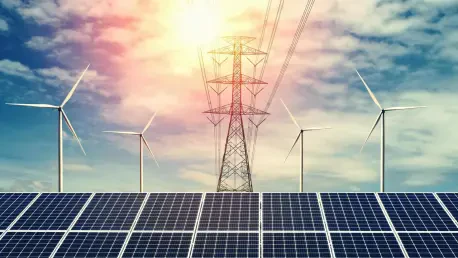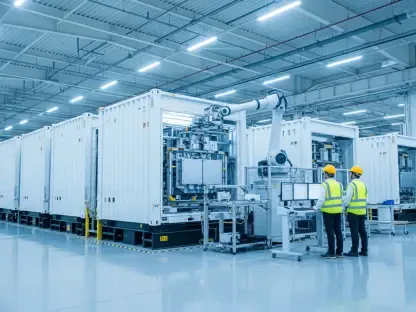In the face of burgeoning global energy demands, the necessity for renewable energy networks that can meet these needs by 2050 has never been more pressing. Industrial growth, technological advances, and shifting consumer behaviors are significantly influencing this demand. As industries and consumers alike push for more sustainable energy solutions, investment in infrastructure and innovation is crucial. This article explores how various sectors are adapting to this demand and the pivotal role renewable energy networks are expected to play in shaping our energy future.
Electrification and Industrial Transformation
The Shift Towards Electrification
Industries across the globe are recognizing the urgent need to pivot toward electrification to meet carbon reduction and sustainability goals. Notably, sectors such as oil, gas, and mining are at the forefront of this transformation. By adopting electrical alternatives, these traditionally fossil fuel-dependent industries are striving to reduce their carbon footprint. In particular, the mining sector sees electrification not only as an environmental necessity but as a driver of economic efficiency. Minerals like lithium, nickel, and cobalt, fundamental to battery production and grid expansion, are in high demand, spurring a shift toward stable and reliable electricity networks. This, in turn, underscores an increased global demand for electricity that is anticipated to rise as industrial electrification processes gain momentum.
Electrification presents numerous challenges, ranging from the substantial initial investment required to the technical know-how needed for seamless integration into existing systems. However, the advantages are manifold. Electrification results in significant reductions in greenhouse gas emissions, aligning industrial practices with international standards for environmental sustainability. Moreover, it opens avenues for innovation within industries, fostering the development of new technologies and processes that enhance efficiency and productivity. As industries continue on this path, reliance on sustainable, renewable energy sources becomes not just an option but an operational imperative.
Decarbonization Initiatives
The drive towards decarbonization is reshaping how industries operate, with technologies such as Carbon Capture and Storage (CCS) gaining prominence. CCS technologies are pivotal in reducing industrial carbon footprints, capturing emissions that would otherwise enter the atmosphere and storing them securely. Coupled with this is the growing adoption of electric machinery across various sectors, marking a distinct move away from fossil fuel-driven operations. Such shifts are indicative of a broader commitment to green practices, with many industries also embarking on the construction of renewable energy plants to stabilize their energy needs.
Renewable energy plants, powered by solar, wind, or biomass, are integral to the long-term strategy of most industries aiming to lower their carbon emissions. These plants provide a consistent and sustainable energy supply that complements electrification efforts within industrial settings. Furthermore, integrating renewable energy into industrial systems requires robust infrastructure that can accommodate fluctuating power demands while maintaining operational efficiency. This necessitates not only technological advancements but also a collaborative approach to policy-making and planning to support sustainable energy transitions effectively.
The Rise of Digital Technologies
Power-Intensive Data Centers
With the proliferation of digital technologies, data centers have emerged as critical power-intensive components in the global economy. The rapid advancements in artificial intelligence, cloud computing, and cryptocurrencies are leading to exponential growth in data center operations. These facilities’ power demands have consequently surged, underscoring the need for renewable energy solutions to secure a sustainable future. Data centers, often operational around the clock, require substantial energy to manage cooling systems, server functions, and data storage, driving the need for robust and efficient renewable energy systems to support their activities.
In parallel, the dependency on renewable energy solutions in powering data centers reflects a growing awareness of environmental responsibilities within tech industries. Many leading technology companies are committing to sourcing their energy needs from renewable sources, aligning their operations with broader sustainability goals. The transition to renewables not only aids in reducing the carbon footprint of data centers but also fosters innovation in energy management and efficiency. Moreover, the investment in renewable energy infrastructure for these centers illustrates a more widespread shift towards greener practices within the digital economy, setting a precedent for future developments.
Expanding Consumer Use
As consumers increasingly adopt technologies like electric vehicles (EVs) and energy-intensive home appliances such as air conditioners, the global demand for electricity is set to rise substantially. The expanding use of electric consumer goods emphasizes the need for adaptable and expansive electricity infrastructure. EVs, transitioning from an emerging market to a mainstream necessity, require extensive charging networks to accommodate their growing presence. This shift highlights a gap in current infrastructure capacity, necessitating a significant overhaul to meet future demands effectively.
The increasing prevalence of EVs not only demands a robust charging infrastructure but also amplifies the call for renewable energy integration within consumer settings. By adopting cleaner energy sources to power EV charging stations and residential air conditioning units, the energy sector can mitigate the environmental impact of rising electricity consumption. Additionally, the potential for smart technologies to manage and optimize energy use in households underscores the importance of technological innovation in supporting consumer demands. With consumers prioritizing sustainability, industry and policymakers alike must adapt their strategies to accommodate this shift, ensuring energy systems remain resilient and efficient.
Global Economic Growth and Infrastructure Demands
Emerging Economies and Electricity Needs
As emerging economies, particularly in Asia, experience robust economic growth, their electricity needs are escalating in tandem. Countries like China are demonstrating significant industrial expansion, with rising living standards contributing to increased electricity consumption. This phenomenon underscores the importance of adopting sustainable energy solutions to meet these expanding demands. As these economies continue to mature, the alignment of energy policies with global sustainability goals becomes crucial. The interdependence between economic growth and energy consumption highlights the critical need for a strategic approach to energy infrastructure development that supports ongoing industrialization while minimizing environmental impact.
The rise of emerging markets not only fuels global electricity demands but also offers opportunities to implement innovative energy solutions that can be adapted to varying scales. By prioritizing renewable energy sources, these economies can leapfrog traditional fossil fuel-based systems, thereby reducing their carbon footprint significantly. Moreover, fostering partnerships that facilitate technology transfer can accelerate this transition, empowering emerging markets to adopt cutting-edge energy technologies that are sustainable and efficient. The economic implications are vast, promoting investment opportunities and positioning these regions as leaders in the global renewable energy landscape.
Infrastructure Investments
The necessity for significant infrastructure investments to support an expanded grid capacity is increasingly urgent as global electricity demands surge. Enhancing the grid is paramount to incorporating renewable energy sources efficiently, ensuring they meet increased demand levels. Investments in smart grids, energy storage solutions, and transmission lines are essential to achieving this goal, offering the reliability and resilience required for a sustainable energy future. These enhancements not only facilitate the integration of clean energy into existing systems but also provide a framework that supports scalable growth in electricity consumption.
Strategic planning and policy support play a vital role in achieving successful infrastructure investments. Government interventions, through subsidies or incentives, can encourage private sector engagement in infrastructure development. Furthermore, international cooperation can foster shared knowledge and resources, expediting the green transition needed to meet global energy needs. By leveraging these collaborative efforts, energy networks can evolve to become more adaptive, driving innovation and efficiency across sectors. Through a proactive approach that prioritizes infrastructure enhancements, the path toward a sustainable global energy future can align more closely with environmental and economic objectives.
Trends and Unified Perspectives
Collaborative Efforts and Innovation
The transition towards electrification and renewable energy solutions encompasses an extensive collaborative effort across various industries. This movement represents a convergence of interests, with traditional sectors like manufacturing and transportation joining the high-tech and utilities sectors in pursuing a shared decarbonization agenda. Innovative energy generation and storage technologies are at the forefront of these efforts, representing significant strides towards achieving global energy goals. Strategic partnerships are also emerging as a powerful tool in the electrification journey, allowing companies and organizations to pool their resources and expertise to overcome challenges that could hamper progress.
Collaboration extends beyond corporate entities to include academic institutions, governments, and international bodies dedicated to fostering innovation in sustainable energy technologies. Such partnerships encourage robust research and development initiatives, laying the groundwork for technological breakthroughs that can be scaled to meet widespread electrification needs. Additionally, collaboration facilitates an exchange of best practices and insights, providing a basis for uniform policies that bolster the effectiveness of renewable energy integration globally. Collectively, these efforts illuminate a pathway to a future where sustainable energy networks are not only theoretically feasible but practically attainable through cooperation and innovation.
Future Outlook
In the face of rapidly increasing global energy demands, the urgent need for renewable energy networks by 2050 has become more crucial than ever. Factors such as industrial growth, technological advancements, and changing consumer behaviors are significantly driving this demand. Today, both industries and consumers are increasingly advocating for sustainable energy solutions, recognizing the importance of transitioning away from traditional, non-renewable sources. To achieve this shift, significant investment in infrastructure and technological innovation is essential. This development is crucial not only for meeting energy demands but also for ensuring environmental sustainability. Various sectors are starting to adapt to this evolving demand, implementing changes to integrate renewable sources like solar, wind, and hydropower. As these sectors adjust and evolve, renewable energy networks will play a critical role in shaping a more sustainable energy future. This transformation is anticipated to foster a more resilient and efficient energy landscape, helping mitigate climate change impacts, reduce carbon footprints, and ensure a reliable energy supply for future generations. Ultimately, this proactive approach towards renewable energy networks will be fundamental in addressing the global energy challenge by 2050, promoting sustainability, and supporting economic growth.









